All you need to know to visit Castel Sant’Angelo, Hadrian’s Mausoleum, one of Rome’s most beautiful yet underrated sites.
Castel Sant’Angelo is an imposing castle located on the banks of the River Tiber, in Rome.
The building is the ancient tomb of Emperor Hadrian, a Papal Fortress and the only castle in the city of Rome.
It is a remarkable site but, oddly, a bit of a Rome hidden gem too.
You may think a big castle complete with turret and cannons is hard to miss, however, this seems to be very much the case when it comes to Castel Sant’Angelo, Rome’s castle.
Located on the banks of the River Tiber, a short walk from both Piazza Navona and the Vatican, Castel Sant’Angelo is a beast of a thing and attracts quite a bit of attention.
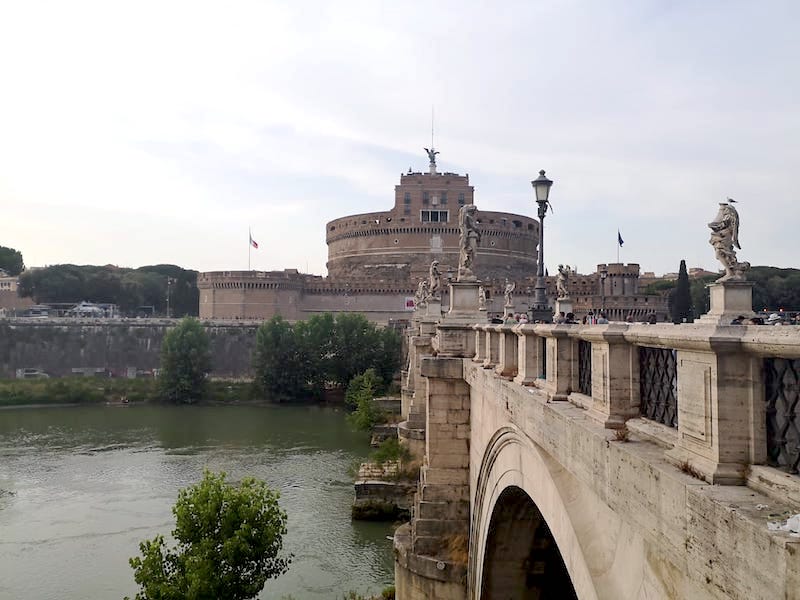
On any given day, you will find many tourists crowding the bridge leading to it, taking selfies or trying to capture its significant height.
However, few of these visitors also take the time to visit the castle inside and this is great if you are one of the few who does but it is also a puzzling fact.
Castel Sant’Angelo is beautiful inside and the only reason I can find for its somewhat limited popularity is possibly the proximity of the Vatican, a neighbor so famous pretty much nothing else stands a chance!
It is well worth visiting Castel Sant’Angelo while traveling in Rome.
I believe Castel Sant’Angelo is one of the most beautiful historical sites in Rome.
I highly recommend you visit inside: this is my guide to Castel Sant’Angelo, Rome.
Please note: this post contains affiliate links and, should you make a purchase through them, we might make a small commission.
What is special about Castel Sant’Angelo
Castel Sant’Angelo has a very peculiar history that makes it one of the most unique buildings in Rome.
The castle was originally not a castle at all by rather the tomb of Emperor Hadrian, who died in 138 AD.
Its official name is ‘Mole Adriana’ or ‘Mausoleo di Adriano’ (Hadrian’s mausoleum, Hadrian’s burial place) and while the shape of the building has changed significantly over time, it is still possible to observe many elements of the original structure, such as the monumental entrance and the internal staircase that brings to the funeral chamber.
This original use as an Emperors’ funeral monument, however, didn’t last long: in 271 Emperor Aurelianus included the mausoleum into the new walls around Rome (the Aurelian Walls, named after him) and effectively turned it into a fortified structure to protect the city.
Since then, the ‘castle’ has known several incarnations: it has been used as a fortress, as a prison, as Pope residence, as solders barrack and finally has now become a National museum.
Because of this consistent use and metamorphoses, Castel Sant’Angelo is one of the most interesting places to visit in Rome to learn about the history of the city.
From its top, you can also enjoy one of the best views of Rome: the panorama from the top terrace is breathtaking!
How to get to Castel Sant’Angelo: map
Castel Sant’Angelo is on the banks of the river Tiber, close to the Vatican and St Peter, to which is connected by the so-called ‘passetto’ (more about it later!).
Its official address is Lungotevere Castello and the bridge that leads to its door is called Ponte Sant’Angelo.
You can reach Castel Sant’Angelo:
On foot: The castle is a short walk from Piazza Navona (about 10 mins) and Piazza San Pietro (about 5 minutes).
By bus: the best buses to get to Castel Sant’Angelo are;
- 62, 23, 271, 982, 280 (stop: Piazza Pia)
- 40 (Piazza Pia, bus terminus)
- 34 (stop: via di Porta Castello)
- 49, 87, 926, 990 (Piazza Cavour-via Crescenzio)
- 64, 46 (stop: Santo Spirito)
The closest metro stations to Castel Sant’Angelo are Lepanto and Ottaviano.
If you are new to the city, you may find our guide to public transportation in Rome handy
How to get tickets for Castel Sant’Angelo
Please note: from September 2021 access to Castel Sant’Angelo, like all cultural venues in Rome, is subject to being in possession of a ‘Green Pass’ or equivalent. Please click on the links for information from each tour provider about what entry requirements and check they carry out.
The best ways to get tickets to Castel Sant’Angelo are:
From the official castle website – these tickets tend to be the cheapest but also the least flexible in terms of changing of dates / time / cancellation.
Rome Castel Sant’Angelo Tour with fast track access: 2h group tour of the castle with live guide
Castel Sant’Angelo and Terrace Tour – 3 hour guided tour with live guide
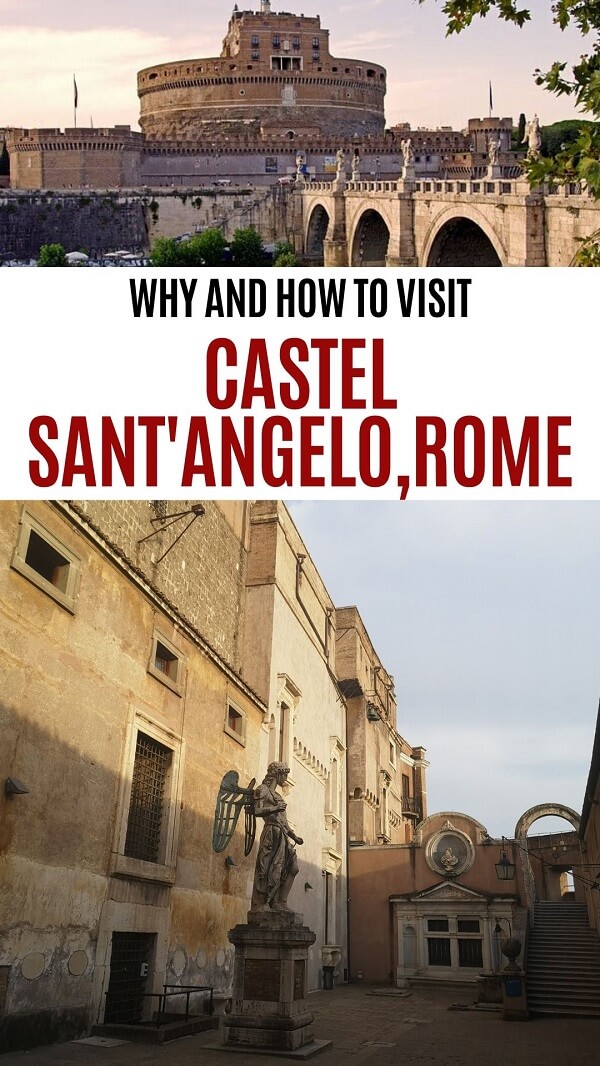
What to wear to visit Castel Sant’Angelo?
Despite its history as Papal residence, Castel Sant’Angelo is a historical site, not a religious one, and no particular dress code is necessary.
I do however recommend to wear comfortable shoes when visiting: some of the steps and passageways in the castle can be a little slippery so runners or anyway good walking shoes are handy to have (walking sandals are ok too).
You can find my recommended walking shoes for Rome here.
Visiting Castel Sant’Angelo with kids
Castel Sant’Angelo is a fantastic Rome attraction to visit with kids of primary school age and up and a real treat especially if in Rome with tweens.
The castle has the feel of a fortress, with turrets, bastion walks, bridges and cannons and it is full of stories and legends that are guaranteed to pique their interest.
For the best experience for kids, I recommend you opt for a guided tour such as this one, which will compensate for the otherwise dry description of the place offered by the info panels.
I believe Castel Sant’Angelo is one of the best things to do in Rome with kids of school age!
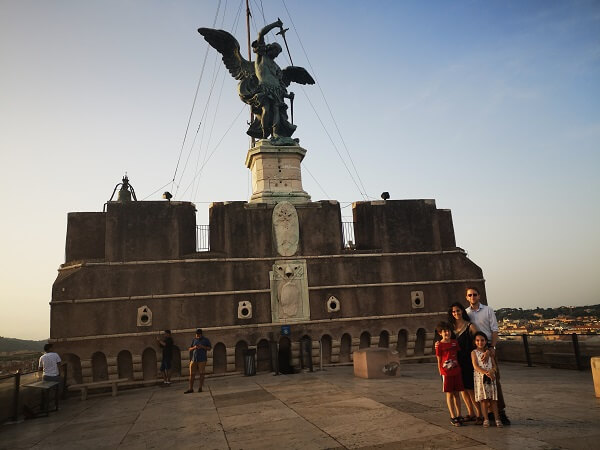
Visiting Castel Sant’Angelo with toddlers is not easy.
Only some areas of the castle are accessible, Castel Sant’Angelo is not suitable for strollers and prams and the highest areas of the castle require a lot of attention – this is not a place where you can leave a toddler to run on their own and there is little for them to play with.
If visiting Castel Sant’Angelo with a baby or toddler, I recommend you bring a carrier.
What to see in Castel Sant’Angelo
The visit to Castel Sant’Angelo follows a preordained itinerary that makes it easy and interesting.
Several info panels dot your way and this makes it easy to learn the history of the castle and make sure you do not miss anything – all the information on this page that do not link to an external site came for what we learned when visiting the castle itself.
Out of the many interesting parts of the castles, I believe the most interesting are the following:
The bastions
The bastions of Castel Sant’Angelo have been built in several stages and are now form the main path visitors follow to see the castle.
There are steps to reach them but they are easy to negotiate and the walkaways are flat.
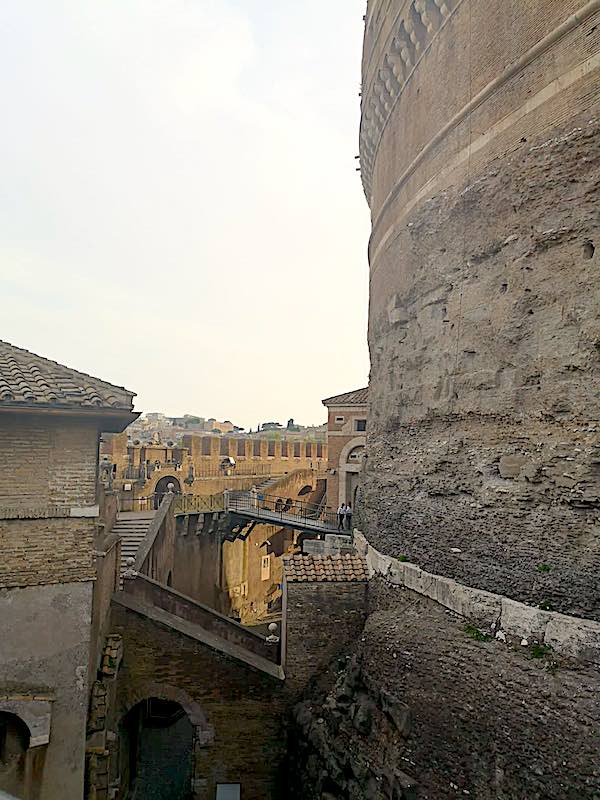
The view is breathtaking and, if you are traveling with kids, they will be delighted to discover the castle has some impressive cannons and cannonballs dating back to the 1600s.
They are on the bastione San Marco, which looks towards the Vatican City and above ‘il Passetto’.
The other bastions are called Bastione San Luca and Bastione San Giovanni: this last one is of particular interest as it used to be the fortress armory.
The bastions, with the cannons and views, are one of the reasons why I recommend families to visit the castle: it truly is one of the best places to visit in Rome with kids!
Hadrian’s Mausoleum Cylinder
From the bastion of San Marco it is easy to admire the incredible cylindrical structure of the original Mausoleum.
The mausoleum has a quadrangular base 86mt large and had, on top, the cylinder we still see today.
The top would have been decorated by a garden, not dissimilar in style to that of the Mausoleum of Augustus, on the other side of the river.
The angel
Castel Sant’Angelo takes its name from Archangel Micheal, said to have appeared at the top of the castle to announce the end of the plague.
Its statue is best seen from the top terrace but you catch glimpses of it from many locations in the castle: don’t forget to look up!
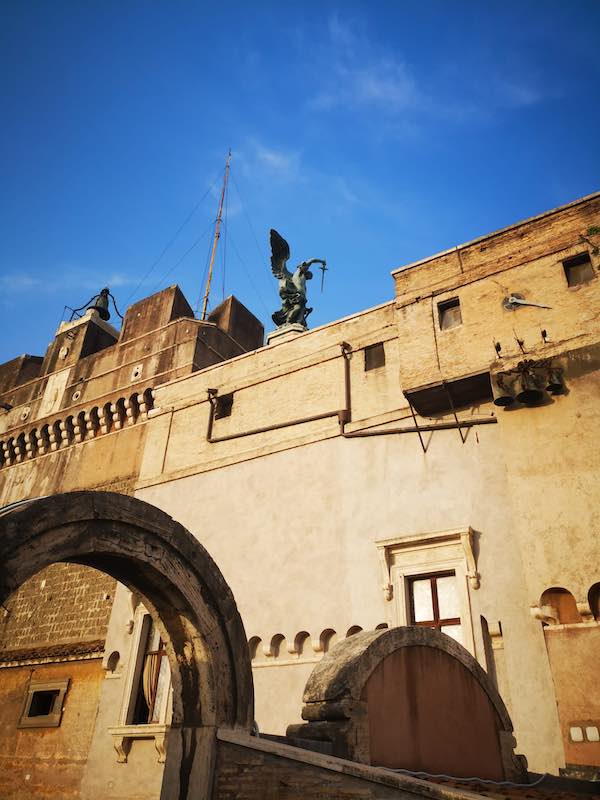
Il passetto
Il passetto di Borgo (or simply ‘il passetto’) is the stretch of walls connecting the Vatican to Castel Sant’Angelo.
It is still visible from the outside and what makes it interesting is that, inside, it hides a secret: a long corridor that allowed the Popes to go from the Vatican to the safety of the fortress in case of attack.
The entrance to the passage is visible from inside the castle and it has occasional openings in summer, in the evening.
At the time of writing the passetto is closed: I will update this article with opening news should information about reopening and booking come available.
Hadrian’s mausoleum
Inside the castle, it is still possible to see the area of Hadrian’s mausoleum, when the ashed of the Antonini’s emperors were kept.
This section of the building is very impressive and used to be decorated with marble slabs, now lost.
While they are not currently visible, it is still possible to guess their existence from the holes in the wall that used to house the metal grips holding the marble in place.
The courtyard and the Pope’s apartments
In the 1400s, the Popes decided to make the castle more comfortable and gave the order to make it into beautiful apartments.
They are still visible (and very impressive) and they open up onto a beautiful courtyard with the statue of Archangel Michael, dating back to 1544!
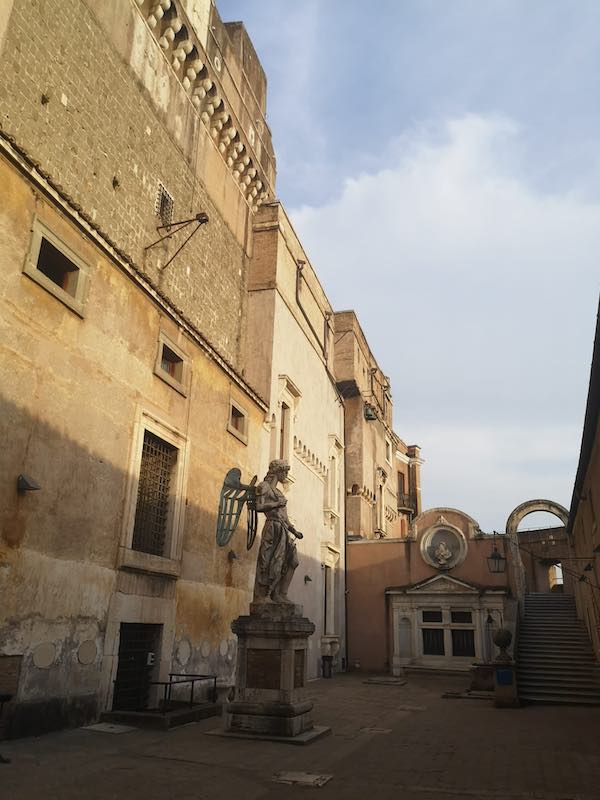
Giretto and grande loggia
‘Il Giretto’ and ‘la grande’ loggia are two of the best areas in the whole of the castle for views.
They are corridors overlooking the city below and they are stunning as they frame the view with beautiful columns and arches, a photographer’s dream!
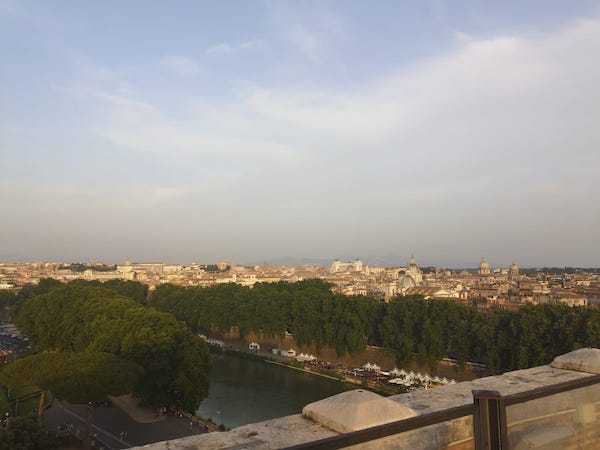
The top terrace
The jewel in the crown in Castel Sant’Angelo is the top terrace.
If you see nothing else here, make sure you climb all the way to the top of the castle because as the view is special: in front you, the whole of Rome opens up and you can not just spot most of its most beautiful and iconic sites but also incredible details of St Peter’s basilica and dome pretty much at your feet!
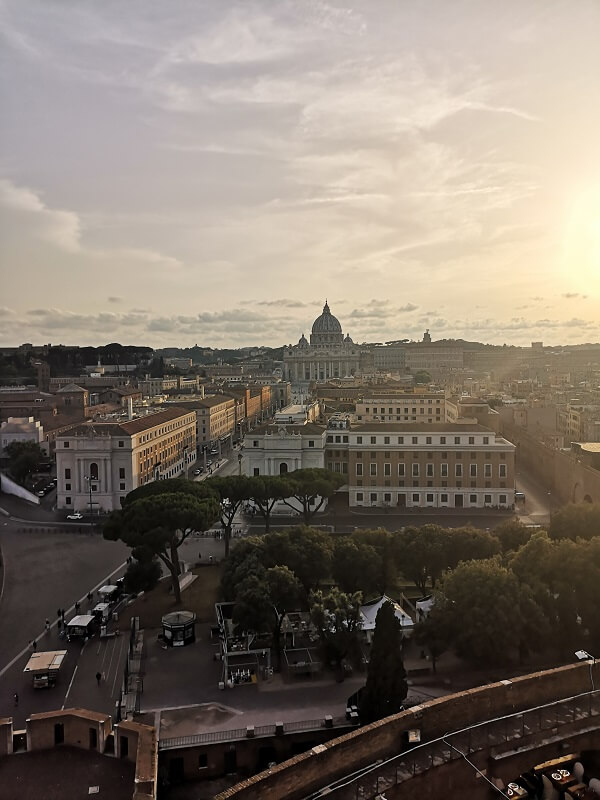
After you have filled your eyes with views over the city, turn around and also take notice of the statue towering above you: it is Archangel Michael sheathing his sword to signal the end of the plague that decimated Rome in the V century.
This list of things to see may seem overwhelming (yet it is not exhaustive) but visiting Castel Sant’Angelo is remarkably simple.
The tourist itinerary is well marked and all you need to do is to follow the signs – they will lead you to all the areas of the castle open to the public.
Special tip for visiting the castle in summer
If you are in Rome in the summer, I highly recommend planning a visit to castell Sant’Angelo just before sunset.
From about 7pm the castle tickets are reduced in price but the views from the top are at their best.
Even better: if your budget allows it, get in right before the ticket prices go down.
While everyone waits for the better deal, you will find yourself pretty much alone in the castle and it is a fabulous feel!
Looking for a special place to propose in Rome? Castel Sant’Angelo has a stunning cafe and restaurant right at the top, one of the most romantic spots in Rome!
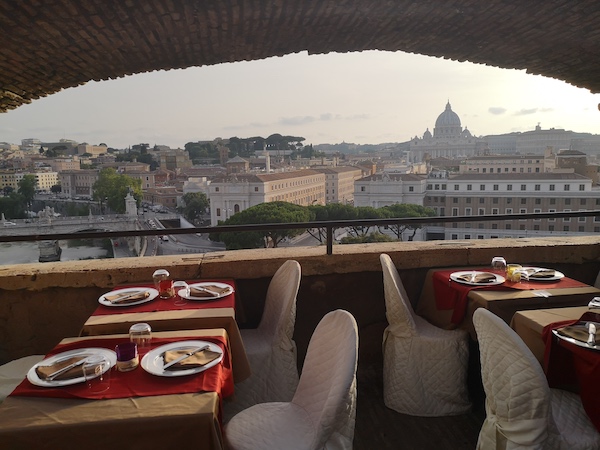
Article updated September 2021

